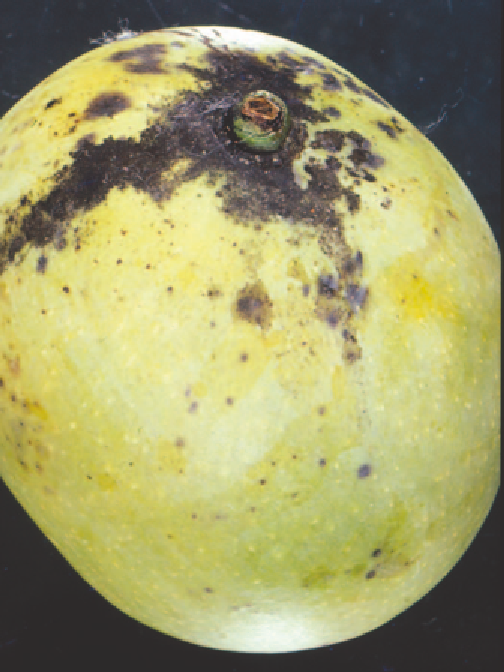Agriculture Reference
In-Depth Information
SOOTY MOULD
plant surface and in insect excreta and are more serious in
humid growing conditions.
■
Cause
Various saprophytic fungi, especially
Capnodium
sp.
Importance
The disease is common in the orchards where mealy bug,
scale insect and hopper are not controlled effectively. The
fungus is essentially saprophytic because it does not derive
nutrients from the host tissues. Although sooty moulds do
not cause disease lesions, their dark, saprophytic growth
makes the fruit surface unsightly, thus impairing market
quality.
Symptoms
In the field, sooty mould is recognised by the presence of
a black, velvety coating (sooty mould) on leaves and fruit.
In severe cases, the trees turn completely black due to
the presence of mould over the entire surface of twigs
and leaves. The disease is more severe when 'honeydew'
secretions (excreta) from insects are present. Honeydew
secretions from insects stick to the leaf surface and provide
the necessary medium for fungal growth. Fungi of this
large group form dense, dark mats of mycelium on affected
living leaves, stems and fruit. This superficial covering can
be rubbed away to reveal undamaged tissue beneath.
Management
•
Control the associated insects and remove the mould by
washing and brushing fruit after harvest.
Prune affected branches and destroy them immediately
to prevent spread of the disease.
•
Source of infection and spread
The growth of these fungi is associated with scale and
dew-secreting insects. Sooty moulds use nutrients on the
STEM-END ROT
■
Cause
Several fungi cause stem-end rot. Anamorphs of
Botryosphaeria
spp. (e.g.
Fusicoccum
spp.,
Neofusicoccum
spp.)
and
Lasiodiplodia theobromae
are the main cause; however,
Phomopsis mangiferae
and
Cytosphaera mangiferae
also cause
the disease.
Colletotrichum gloeosporioides
(the causal agent
of anthracnose) can also cause symptoms at the stem-end of
fruit (usually referred to as 'stem-end anthracnose').
Symptoms
Symptoms appear as the fruit ripens and can vary
according to the causal agent. Generally, a brown, soft
decay starts at the stem end and rapidly rots the whole
fruit. Infected fruit may split open as they collapse. A
straw-coloured f fluid drains from the stem-end or from
splits in the side of the fruit. Steel-grey mycelium may
cover the surface of fruit. The fungus can spread to
adjacent healthy fruit in physical contact.
Lesions may also occur away from the stem-end,
particularly if the fruit has been injured. Flesh of infected
fruit has an off f lavour. Lesions caused by
P. mangiferae
are
generally firmer, have a defined margin, and spread more
slowly than those caused by other stem-end rot fungi.
Stem-end rot caused by
P. mangiferae
can be distinguished
from anthracnose at the stem end by differences in the
fruiting bodies -
P. mangiferae
produces dark, pinhead-size
fruiting bodies;
Colletotrichum gloeosporioides
produces
pink spore masses.
Fig 12.38 Sooty mould is a black, superficial mould easily removed
by rubbing.












